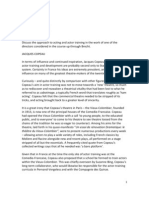Sublimity in Broadway Theatre
Sublimity in Broadway Theatre
Uploaded by
Brandon WeberCopyright:
Available Formats
Sublimity in Broadway Theatre
Sublimity in Broadway Theatre
Uploaded by
Brandon WeberOriginal Description:
Copyright
Available Formats
Share this document
Did you find this document useful?
Is this content inappropriate?
Copyright:
Available Formats
Sublimity in Broadway Theatre
Sublimity in Broadway Theatre
Uploaded by
Brandon WeberCopyright:
Available Formats
Weber 1
Brandon Weber
Michael Warner
Meisner Technique
9 October 2014
The Sublimity Turn of Broadway Theatre
When an audience and theatre-people can feel that they are both the answer to one
another, and that both may act as leaders to one another, there we have Theatre in its truest form.
To create such a Theatre is our real purpose (Page 72). Harold Clurmans 1961 novel, The
Fervent Years: The Group Theatre And The Thirties, captured the revolutionary struggle of
creating a non-commercial theatre that will represent the current events on the Broadway theatre
scene. The Group Theatre was a New York City theatre collective formed by three directors
Harold Clurman, Cheryl Crawford, and Lee Strasberg in 1931. The idea of creating such a
theatre was initiated when Clurman, Strasberg, and Sanford Meisner were all in Richard Rodgers
and Lorenz Harts intimate revue Garrick Gaieties of 1925. During the rehearsals of Garrick
Gaieties Strasberg and Clurman hit off particularly well because Strasberg was more passionate
about theatre, while Clurman was interested in the lack of naturalistic literature in most plays. By
having various discussions on the quality of commercial theatre, the two colleagues appointed a
gathering of theatre innovators to enforce their refreshing take on modern theatre. Immanuel
Kants contribution to the aesthetic theory about art would constitute The Group Theatres
mission to be sublime. The mission of theatre would be considered sublime because the era of
the 1930s was closely to the Dionysian characteristics in which would be reflected in The Group
Theatres production.
One of the first people that were recruited in the selection of theatre innovators was
Weber 2
Cheryl Crawford who worked with Harold Clurman, a play-reader at the time, as the
assistant stage manager with The Theatre Guild. Crawford willingly left her position at The
Theatre Guild because she was empathetic to Clurmans philosophical vision for a change in
theatre. By contributing not only her time, but also financial stability to the founding of this new
theatre she became one of the three directors. Before immersing herself into this theater project,
Cheryl Crawford was born in Akron, Ohio and majored in Drama at Smith College. After
receiving her bachelors degree, she moved to New York City and enrolled into The Theatre
Guilds School. Once Crawford completed her training, the admirable Theresa Helburn hired her
in 1927. Theresa Helburn was an influential figure in the 20
th
century due to being the literary
manager, casting director, and eventually a co-producer of The Theatre Guild. Crawford
maintained a valuable position in selecting, directing, and co-producing The Groups Theatre
plays, including their opening show The House of Connelly.
Lee Strasberg was born in Budaniv to Jewish parents who in 1909 the family reunited
after the slight separation from each other in Lower East Manhattan. Although being a straight-A
student, dropping out of high school became a loophole of opportunities for him. A close relative
introduce him into the world of theater by giving him a small part in a Yiddish-language
production performed with the Progressive Drama Club. Philip Loeb sensed that Strasberg had
the gift to act and encouraged him to continue with his undeniable talent. When Lee was twenty-
three years old, he enrolled into the Clare Tree Major School of Theater, but quickly left the
program in order to study with Constantine Stanislavskis students Maria Ouspenskaya and
Richard Boleslavsky. Stanislavski taught his intriguing technique at The Moscow Art Theatre in
which he built by using the wealth of his family in 1898. The venue was conceived for
naturalistic, in contrast to the melodramas that were becoming dominant in the theatre scene in
Weber 3
Russia. The Stanislavski System is a progression of techniques to train actors to draw
believable emotions to their performances. The aim of the system was to enable the actor to use
himself more consciously as an instrument for the attainment of truth on stage. It was based off
the concept of emotional memory for which an actor focuses internally to portray a characters
emotion on stage. Lee Strasberg used many exercises and warm-ups from this technique while
training the actors for The Group Theatres performances. The Actors Committee for The
Group Theatre expressed some of their opinions of Strasberg in a resolution document. Lees
great courage, his doggedness, his arbitrariness, his need to be right, his cold scorn of artistic
compromise, his clannishness, his removal from life, his hysterical force (used as threat) and
above all brute domineering of his will. We believe that Lee under the new organization should
relieved for some time of all, but purely artistic tasks... (Page 194)
On September 18, 1901, Harold Clurman was born on the Lower East side of Manhattan.
His parents took him to see Yiddish theater at the age six; the performances by Jacob Adler
fascinated him. After attending Columbia, he would soon move to France to study at The
University of Paris. He shared an apartment with his friend Aaron Copland, a talented composer,
in Paris. In my eyes, the theatre seemed to become ever less important. I enjoyed seeing plays
but my mind was left dissatisfied (Page 5). Nonetheless, influenced by the work of Jacques
Copeau, Clurman returned to New York City and started working as an extra in plays. To expand
his knowledge he decided to play read and stage-manage for The Theatre Guild along side
Cheryl Crawford. By having the likelihoods of Lee Strasberg and Cheryl Crawford on his side
they started changing the view of American Theatre with shows like Men in White, Waiting for
Lefty, Awake and Sing, and their biggest hit Golden Boy all produced under the rights of The
Group Theatre. The balance amongst the trio was set in stone and affected the ambiance of the
Weber 4
theater. Lee Strasberg was the main director and acting technique trainer, Cheryl
Crawford was the second director and provided funding for most of the shows, and Harold
Clurman was dramaturgy management director due to the lack of directorial hits. Clurman also
manufactured himself to become the push over in the group. The amount of plays and
questionable directional approaches, he let them slide because he thought the audience would
appreciate the contrast of glamorized theatre. Some individuals like Stella Adler had her own
vibrant opinions about the way The Group Theatre seasons fell among the theater circuit.
Disregarding her opinions on the success of the theater company, Stella Adler fell in love with
Harold. The relationship was perceived as awkward, yet intriguing because Adler was interested
not only to be known as an overly diverse actress, but creating her own revolutionary acting
technique.
There were other actors who provided a substantial amount of significance in artistic
achievement, such as Elia Kazan. Elia Kazan was a Greek American director, producer, writer
and actor, described by The New York Times as one of the most honored and influential directors
in Broadway and Hollywood history. He joined The Group Theatre after attending two years at
The Yale School of Drama during the second summer production. Some of his notable works
include A Streetcar Named Desire, On the Waterfront, and East of Eden. Another great influence
was Clifford Odets, who is from Philly and after sitting through ten meetings with Harold
Clurman spewing lectures at him, understood what he was trying to contribute to theater. He
became the main playwright for The Group Theatre, yet his some of his earlier works were
considered inconceivable left-wing propagandas. Odets major hit play was Golden Boy due to
focus on interpersonal relationships affected by moral dilemmas. Last, but not least Sanford
Meisner had a large impact on theater due to his technique that evolved from Method Acting. He
Weber 5
totally abandoned the use of affective memory and emphasized the art of doing. As
well as being apart of The Group Theatres productions as one of the main actors, he became the
head of the acting program at The Neighborhood Playhouse after the disbanding The Group
Theatre. Also he was one of the first teachers to teach at the renounce Actors Studio.
You might also like
- Knowing The Body: Malmgren ActingDocument315 pagesKnowing The Body: Malmgren ActingJordanCampbell100% (3)
- Wa Thiongo, Ngugi. 1997. Enactments of PowerDocument21 pagesWa Thiongo, Ngugi. 1997. Enactments of PowergeorgelifeNo ratings yet
- THE FROGS - Scene 1Document4 pagesTHE FROGS - Scene 1DenyNo ratings yet
- Top IMDB 1000 Actors - 1 January 2018Document26 pagesTop IMDB 1000 Actors - 1 January 2018SupermarketulDeFilmeNo ratings yet
- TEXT WORK Breakdown From Complete Stanislavski ToolkitDocument3 pagesTEXT WORK Breakdown From Complete Stanislavski ToolkitVj Kamilo100% (1)
- Up-Ending The Tea Table: Race and Culture in Mary Zimmerman's The Jungle BookDocument23 pagesUp-Ending The Tea Table: Race and Culture in Mary Zimmerman's The Jungle BookDavid Isaacson100% (2)
- Project 3 - Home by Nadia FallDocument4 pagesProject 3 - Home by Nadia Fallapi-539987941No ratings yet
- ACleanSweepfortheFutureofArt PDFDocument8 pagesACleanSweepfortheFutureofArt PDFBrandon WeberNo ratings yet
- What Is ActingDocument26 pagesWhat Is Actingadinfinitya100% (3)
- Copeau EssayDocument6 pagesCopeau EssayConor HanrattyNo ratings yet
- Notes On Sanford MeisnerDocument1 pageNotes On Sanford MeisnerGiselle RoblesNo ratings yet
- Moscow Art TheatreDocument37 pagesMoscow Art TheatreDan BuckNo ratings yet
- How Renée Fleming Inspired The Met Opera's The Hours - PlaybillDocument8 pagesHow Renée Fleming Inspired The Met Opera's The Hours - PlaybillmusicrocksqwertyNo ratings yet
- Angels in America (YURE)Document1 pageAngels in America (YURE)Mvl KakashiNo ratings yet
- What Does An Actor DoDocument4 pagesWhat Does An Actor DoColeen gaboyNo ratings yet
- Stella Adler ResearchDocument1 pageStella Adler Researchapi-568417403No ratings yet
- Guidelines For Stage Play AnalysisDocument4 pagesGuidelines For Stage Play AnalysisMarxKristoferDeVeraNo ratings yet
- Comparison Meyerhold StanDocument15 pagesComparison Meyerhold StanHaneen HannouchNo ratings yet
- Stella A 1Document2 pagesStella A 1api-574033038No ratings yet
- Meyerhold & Mayakovsky - Biomechanics and The Communist UtopisDocument27 pagesMeyerhold & Mayakovsky - Biomechanics and The Communist UtopisViv BolusNo ratings yet
- Anthon Chekhov at The MAT. Smeliansky.Document13 pagesAnthon Chekhov at The MAT. Smeliansky.NinaReeceNo ratings yet
- Carnicke On Stan 1Document12 pagesCarnicke On Stan 1BethNo ratings yet
- Theatre Lesson PlanDocument5 pagesTheatre Lesson PlanCarleighNo ratings yet
- Michael ChekhovDocument2 pagesMichael Chekhovapi-541653384No ratings yet
- Alfreds WorkshopDocument6 pagesAlfreds WorkshopRebecca Elaine StevensNo ratings yet
- Acting Methods (Presentation) Author West Ada School DistrictDocument12 pagesActing Methods (Presentation) Author West Ada School DistrictblastergunmanNo ratings yet
- A Midsummer Night-ScriptDocument11 pagesA Midsummer Night-ScriptLovelea NapaNo ratings yet
- Script Analysis NotesDocument29 pagesScript Analysis NotesBrian IrelandNo ratings yet
- Actors: Showing ActionDocument18 pagesActors: Showing ActionTadele Molla ታደለ ሞላNo ratings yet
- Analysis of PlaysDocument4 pagesAnalysis of Playspeter_yoon_14No ratings yet
- A Higher Calling Phillip Seymor HoffmanaDocument14 pagesA Higher Calling Phillip Seymor Hoffmanaalchymia_ilNo ratings yet
- Actor and The TargetDocument6 pagesActor and The TargetKali SharmanNo ratings yet
- What Is TheatreDocument20 pagesWhat Is TheatreAnonymous KuKhGEZyA100% (1)
- Rodgers & Hammerstein Organization, Musical Theatre International and The Really Useful Group Lawsuit Against American Music Theatre in Lancaster, Pa.Document49 pagesRodgers & Hammerstein Organization, Musical Theatre International and The Really Useful Group Lawsuit Against American Music Theatre in Lancaster, Pa.LNP MEDIA GROUP, Inc.100% (1)
- Drama: Past To PresentDocument12 pagesDrama: Past To PresentEtherial WyvernNo ratings yet
- Acting (Re) Considered - Preface ChapterDocument4 pagesActing (Re) Considered - Preface ChapterRiley SpadaroNo ratings yet
- Our Town InformationDocument12 pagesOur Town Informationchildress8No ratings yet
- Approaches To Acting.1Document8 pagesApproaches To Acting.1joshuabonelloNo ratings yet
- My Life With The Voice ArticleDocument14 pagesMy Life With The Voice ArticleMark James HamiltonNo ratings yet
- Tesis-Steele Mackey-Delsarte PDFDocument320 pagesTesis-Steele Mackey-Delsarte PDFwichita_lmvNo ratings yet
- Atypical Episode Script Transcript Season 1 02 A Human FemaleDocument54 pagesAtypical Episode Script Transcript Season 1 02 A Human FemaleAlina ManoiloNo ratings yet
- 01 Pronunciation and DialectsDocument29 pages01 Pronunciation and DialectsPablo GomezNo ratings yet
- The Ultimate List of Acting Verbs 2Document3 pagesThe Ultimate List of Acting Verbs 2Vítor D'AlmeidaNo ratings yet
- Books and Resources For The ActorDocument2 pagesBooks and Resources For The ActoramarghitoaieiNo ratings yet
- A Guide To The Theory of Drama by Manfred JahnDocument45 pagesA Guide To The Theory of Drama by Manfred JahnPau StrangeNo ratings yet
- Moseley, The Psycho and The Physical in Psycho-Physical ActioningDocument19 pagesMoseley, The Psycho and The Physical in Psycho-Physical ActioningTR119No ratings yet
- Acting and Directing in The Lyric Theater An Annotated ChecklistDocument12 pagesActing and Directing in The Lyric Theater An Annotated Checklistvictorz8200No ratings yet
- 4 Ways To Prepare For Pilot Season Like A Pro Copyright Amy Jo Berman 2019Document10 pages4 Ways To Prepare For Pilot Season Like A Pro Copyright Amy Jo Berman 2019Zaarin BushraNo ratings yet
- Stanislavski Scene AnalysisDocument6 pagesStanislavski Scene AnalysisSofia RodriguezNo ratings yet
- Dates / Period Key Styles Key Playwrights Greek Theatre: 600BC-600AD ClassicalDocument9 pagesDates / Period Key Styles Key Playwrights Greek Theatre: 600BC-600AD Classicaldick white100% (1)
- Acting NotesDocument3 pagesActing Notesapi-676894540% (1)
- Meyerhold's Key Theoretical PrinciplesDocument27 pagesMeyerhold's Key Theoretical Principlesbenwarrington11100% (1)
- The Routledge Companion To Jacques Lecoq: Mark Evans, Rick KempDocument9 pagesThe Routledge Companion To Jacques Lecoq: Mark Evans, Rick KempMatthewE036No ratings yet
- Directing With The Michael Chekhov Technique by Mark MondayDocument4 pagesDirecting With The Michael Chekhov Technique by Mark MondaynervousystemNo ratings yet
- Unit 7Document20 pagesUnit 7Kishor PatilNo ratings yet
- 15 Minute Practitioners Uta HagenDocument8 pages15 Minute Practitioners Uta HagenJason ShimNo ratings yet
- Stella AdlerDocument10 pagesStella AdlerNicky Garside100% (1)
- Jacques Lecoq by Sarah LewisDocument1 pageJacques Lecoq by Sarah LewisGofri BlogjaNo ratings yet
- Wright, 8 Acting TechniquesDocument2 pagesWright, 8 Acting TechniquesTR119No ratings yet
- Katie MitchellDocument3 pagesKatie Mitchellapi-568417403No ratings yet
- Model Proforma For Income CertificateDocument1 pageModel Proforma For Income CertificateSreejita KoleyNo ratings yet
- Ch. 10 - Musical Theatre (2) - TaggedDocument12 pagesCh. 10 - Musical Theatre (2) - TaggedJames M.100% (1)
- THVC331 03 Voice Lesson For Musical Theatre Fall 2015 InstructorDocument4 pagesTHVC331 03 Voice Lesson For Musical Theatre Fall 2015 InstructorBrandon WeberNo ratings yet
- Rock The Presidents SynopsisDocument1 pageRock The Presidents SynopsisBrandon WeberNo ratings yet
- The Wild Party: Brandon WeberDocument12 pagesThe Wild Party: Brandon WeberBrandon WeberNo ratings yet
- V I E W P O I N T S: HW3 - Character Presentation - From A Play, Musical or ScreenplayDocument2 pagesV I E W P O I N T S: HW3 - Character Presentation - From A Play, Musical or ScreenplayBrandon WeberNo ratings yet
- Hints On Household TasteDocument9 pagesHints On Household TasteBrandon WeberNo ratings yet
- Socialisation of Gender RolesDocument21 pagesSocialisation of Gender RolesBrandon WeberNo ratings yet
- The University of The Arts: Rhaynes@uarts - EduDocument2 pagesThe University of The Arts: Rhaynes@uarts - EduBrandon WeberNo ratings yet
- V I E W P O I N T S: 50 PAGES of The Viewpoints Book Page 80 - AfterwordDocument1 pageV I E W P O I N T S: 50 PAGES of The Viewpoints Book Page 80 - AfterwordBrandon WeberNo ratings yet
- Call Sheet Jose R.Document2 pagesCall Sheet Jose R.Brandon WeberNo ratings yet
- Ental Pplication: (If Less Than Three Years Ago)Document2 pagesEntal Pplication: (If Less Than Three Years Ago)Brandon WeberNo ratings yet
- The Search For A New BeautyDocument12 pagesThe Search For A New BeautyBrandon WeberNo ratings yet
- By Lewis CarrollDocument3 pagesBy Lewis CarrollBrandon WeberNo ratings yet
- Cover Letter: Theatre Arts CenterDocument1 pageCover Letter: Theatre Arts CenterBrandon WeberNo ratings yet
- Three Elements of DramaDocument21 pagesThree Elements of DramaHUMSS 23 - Yñigo James D. AñabezaNo ratings yet
- BA Screen Acting Reading ListDocument4 pagesBA Screen Acting Reading ListMihai CostacheNo ratings yet
- Theater ArtsDocument4 pagesTheater ArtsMariemar CamposanoNo ratings yet
- Singing For The ActorDocument86 pagesSinging For The ActorDavidNo ratings yet
- Q2 - Grade8 - Introduction To Theater of RealismDocument48 pagesQ2 - Grade8 - Introduction To Theater of RealismJun Adibasi100% (1)
- Royal Central 2014 ProspectusDocument116 pagesRoyal Central 2014 ProspectusElise HarringtonNo ratings yet
- Arts04a Quiz ReviewerDocument2 pagesArts04a Quiz ReviewerJan-Rhada Ilao AmarilaNo ratings yet
- r10 - E2 - Students Class Wise ListDocument93 pagesr10 - E2 - Students Class Wise ListamithbaluNo ratings yet
- Readers Theater and Chamber TheaterDocument41 pagesReaders Theater and Chamber TheaterCrissa MaeNo ratings yet
- Guide BookDocument44 pagesGuide BookLance Gabriel de JesusNo ratings yet
- Aspects of ProductionDocument88 pagesAspects of ProductionBurning Rose50% (2)
- Fundamentals of Theatre Notes - Docx 20241009 110740 0000Document6 pagesFundamentals of Theatre Notes - Docx 20241009 110740 0000spectatorindia7No ratings yet
- Stephanie Braun Jacobson CVDocument7 pagesStephanie Braun Jacobson CVapi-285828792No ratings yet
- Estelle BAJOU - CV - 2018Document14 pagesEstelle BAJOU - CV - 2018Estelle BajouNo ratings yet
- Jeanne Mailloux: TrainingDocument1 pageJeanne Mailloux: TrainingJeanne MaillouxNo ratings yet
- Cgl2016 Tier 1 Result SR Qualified Candidates ListDocument177 pagesCgl2016 Tier 1 Result SR Qualified Candidates ListmaheshNo ratings yet
- Brochure PDFDocument28 pagesBrochure PDFAnonymous gApn0Z9wNo ratings yet
- ENGLISH WORKSHEET Grade 6 WEEK 6Document4 pagesENGLISH WORKSHEET Grade 6 WEEK 6GIRLIE MAY ARANJUEZNo ratings yet
- SYLLABUSDocument46 pagesSYLLABUShh rickyNo ratings yet
- Theatre Studies: (Code No. 078)Document6 pagesTheatre Studies: (Code No. 078)Tanvi RahejaNo ratings yet
- Viewpoints of Space-Spatial RelationshipsDocument7 pagesViewpoints of Space-Spatial RelationshipsPaul SullivanNo ratings yet
- EBOOK Theatre A Way of Seeing 7Th Edition Download Full Chapter PDF KindleDocument61 pagesEBOOK Theatre A Way of Seeing 7Th Edition Download Full Chapter PDF Kindlethomas.matthews680100% (44)
- Film Conventions q1 (W1-10)Document51 pagesFilm Conventions q1 (W1-10)DianArtemiz Mata Valcoba100% (1)
- Rose Bruford Foundation ClassesDocument12 pagesRose Bruford Foundation Classestom whithersNo ratings yet
- The Most Popular Acting TechniquesDocument5 pagesThe Most Popular Acting TechniquesAiken Cuaderno100% (1)
- Blocking Bingo SheetsDocument7 pagesBlocking Bingo Sheetsjenna smithNo ratings yet
- Stellaadler - Docxwith BlanksDocument5 pagesStellaadler - Docxwith BlanksKerstin FrankeNo ratings yet







































































































